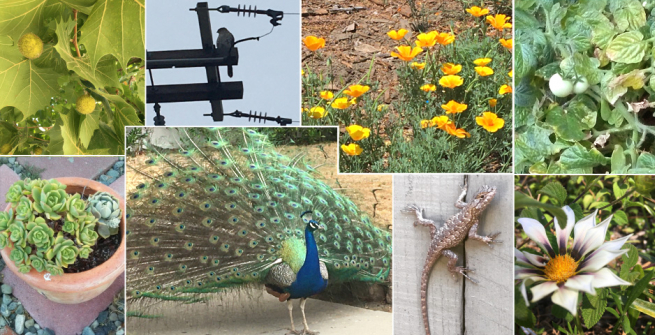For many families in Los Angeles, taking a socially-distanced stroll around the neighborhood has been a major activity over the past few months, a type of recreation that feels essential for our mental and physical health. Children of all ages (and their grown-ups, too) can benefit from some time outside, even if it’s only the view from the sidewalk. But whether you’re on foot, a bike, a stroller, or another mobility device, by now you or your kids might be a bit bored of seeing the same few blocks over and over. How can we bring a bit more fun, excitement, and learning to our daily constitutional? Let’s take a nature walk around the neighborhood!
Babies and little ones
With the smallest children, anything can become an opportunity for learning. During baby and preschool storytimes, we often talk about the five early literacy practices of reading, talking, singing, writing, and playing, but these aren’t limited to the library or even your house. A neighborhood walk is the perfect chance to develop language skills through play.
My nephew was a toddler who hated naptime, so many times I’d push his stroller around the block while reciting the story Brown Bear, Brown Bear, What Do You See? (which I had probably read to him 5,000 times), trying to get him to fall asleep. If you don’t remember the words of a favorite book, you can make up your own version:
Baby, baby what do you see?
I see a brown squirrel looking at me!
Brown squirrel, brown squirrel, what do you see?
I see some green grass looking at me!
If that gets boring, you can make up a silly song about the things you see around you. Your neighbors might laugh, but that’s okay!
As children grow more active, they might love to play a round of “I Spy,” the alphabet game, or a rhyming challenge while on the go. By talking about the world around them and asking open-ended questions, you’re teaching children new vocabulary and developing their conversational skills. When you get home they can draw a picture or “story” inspired by what they’ve seen, which then makes the connection to writing.
Third grade and up
For older kids, a nature walk outside can be a good opportunity to practice mindfulness, observation skills, and being present in the moment, especially in a day filled with screen time and other distractions. Birdwatching reminds us to look up once in a while, and searching for bugs or leaves reminds us to observe up close.
A no-touch scavenger hunt game can get children more engaged in a walk while giving them a new perspective on their environment. See who can find some plants growing in a garden, the most interesting tree trunks, flowers of different colors, leaves of different shapes, or the weirdest plant of the day. Whether you have extensive gardens in your neighborhood or just weeds growing through the sidewalk, you can find a bit of nature in the most urban setting.
Inspiration from nature doesn’t have to stay outside. Older children may want to try taking some photos—don’t forget to have a safety talk about staying aware of their surroundings and respecting other people’s privacy—to create an album, or they can keep track of their observations in a nature journal.
At-home science experiments and other DIY activities with a nature theme can continue the fun. The library’s Neighborhood Science page has lots of suggestions for budding scientists to contribute to real-world research projects. And of course, the library has plenty of books to continue the learning process. Check out some reading suggestions in the book list below!













